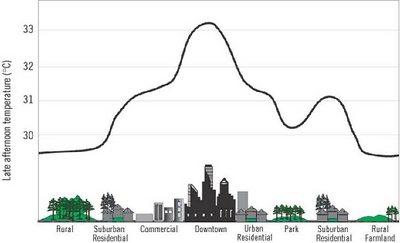| Urban Heat Island
The Fuegosat Consolidation Element is part of the EW programme approved by the ESA Council at Ministerial Level held in Edinburgh in November 2001. A plan of work was agreed with participating states including two steps separated by a Fuegosat Concept Review. Following queries about the mission requirements by Delegations since mid-2006, it was clarified that the initial mission within the EW framework did not entail the definition of mission requirements by the Agency due to the nature of the initial proposal as a private-public initiative. Figure 1 shows the brightness temperature of Madrid city retrieved by an ASTER Thermal channel.

In densely built cities with a low percentage of vegetation and water, the temperatures in the heart of the city might, in some cases, be up to 10º C warmer than in the surrounding countryside. |
A consultation of internal and external infrared EO application experts was therefore initiated by the Agency (this included a one-day workshop at ESRIN on 17 October 2006) with the goal of verifying the impact of IR data at higher resolution than the traditional AVHRR and AATSR on a number of applications relevant for GMES. A high resolution Thermal InfraRed capability was recognized as necessary for Europe in the medium/long term and, in addition to applications that are fire related, additional applications of infrared observations of potential relevance to GMES were identified and considered during the initial requirement consolidation exercise. The applications addressed at the workshop included:
- fire monitoring for climate studies and ecology
- coal mine fires monitoring for ecology
- volcano monitoring
- irrigation water management
- urban climate
- security and surveillance
Taking into account the complementary data and applications supported by other missions such as MSG and MTG for monitoring of large fires (and in the future also medium-size fires) and the Sentinel-2 and -3 for forest fire prevention and post-damage assessment, the following new applications have been preliminary identified as of relevance to GMES services, either initiated or planned, in particular because of their clear relevance to EC policies:
-Urban Heat Islands for micro-climate, energy conservation, carbon emission limitation;
-Security: various kinds of human and industrial activities. including several of interest to law enforcement authorities, may be detected during day or night using high resolution infrared sensors, such as motion of transport means, detection of ships and their routes, industrial operations causing thermal anomalies, waste management, landfill monitoring, energy security, etc.
The reorientation has been recently discussed (October 2007 and February 2008) and endorsed by the Participants to the Fuegosat element (Consolidation phase). In the reorientation is planned the identification of activities to support establishing requirements reconsidering previous studies and through Data User Element (DUE) projects relevant to the infrared element development. Tasks will be added to these DUE projects to prototype products and services using airborne and space sensors and to assess the related operational usefulness and the scope of use in Europe.
A DUE user workshop is also planned for March 2009, but the on going DUE activities will produce relevant inputs before the end of 2008. These currently are going to cover in particular the user requirements for urban heat islands for micro-climate and energy conservation.
Therefore, the aim of DESIREX 2008 airborne campaign is to anticipate generation of thermal datasets to address coming trade-off studies supporting both DUE projects for products prototyping and mission requirements analysis. The "Urban Heat Islands (UHI) and Urban Thermography (UT) Project” [RD2] is a new Earth Observation Application project funded by DUE within the 3rd Earth Observation Envelope Programme starting on July 2008 that includes studies to demonstrate the integration of remote sensing observations, with special focus on NIR/TIR observations, in support to UHI mitigation and Urban Energy Efficiency policies.
In the framework of the DUE UHI and UT project, ESA intends to organise dedicated airborne campaigns (baseline: Madrid 2008 and Athens 2009) on a limited number of cities to generate thermal datasets to be used principally as input to the TIR sensor trade-off study.

|